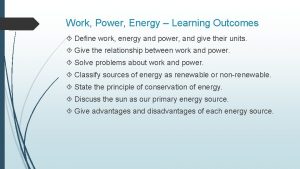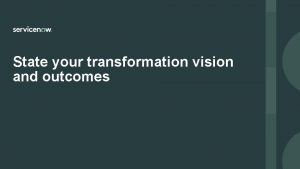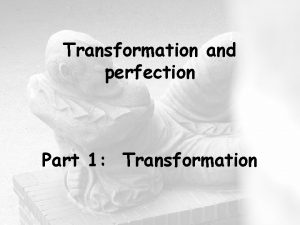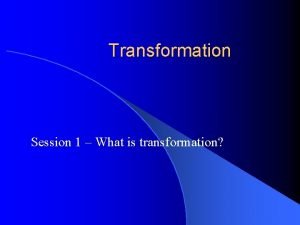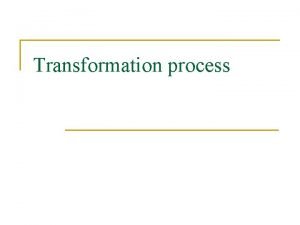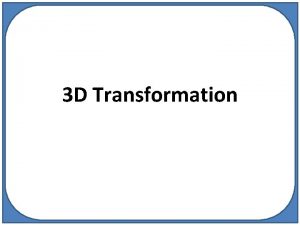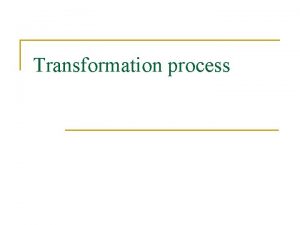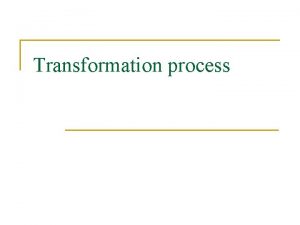State your transformation vision and outcomes State your










- Slides: 10

State your transformation vision and outcomes

State your transformation vision and outcomes Many organizations have digital transformation as a strategic imperative, but few state a vision that translates into tangible and realistic measures of success that can inform planning and budget decisions. A clearly defined and communicated transformation vision and outcomes sets a North Star for teams that are implementing the Now Platform® to deliver business value. It helps them understand how their work contributes to broader business goals and helps senior managers see the benefits of their technology investment. Insight: State your transformation vision and outcomes A strong transformation vision should address four questions: • Vision – What’s the ideal future state for our customers and team? • Expected business outcomes – What business value will we realize? • Desired business capabilities – What execution strategies are necessary to achieve this vision? • Key measures of success – How will we know when we’ve realized our targeted value? In the absence of an effective transformation vision at the organization level, create one for your Now Platform implementation and link it to your company’s established strategic drivers, such as operational excellence, cost reduction, or employee experience. Shape the transformation vision to ensure it translates into measurable outcomes for your team, and effectively communicate it across the organization to support roadmap planning, budget allocation, and prioritization decisions. Regularly revisit the transformation vision and your desired business capabilities as you scale Service. Now® and as your organization’s business strategy evolves. Key implementation steps Start 1. Assess your transformation opportunity Improve 2. Conduct a visioning exercise 3. Define the measures of success 2 Optimize 4. Socialize the vision and outcomes 5. Review and expand the transformation vision © 2020 Service. Now, Inc. All Rights Reserved.

Step 1: Assess your transformation opportunity A strong transformation vision needs to align with the strategic and operational aspirations of the organization. To identify the right direction for your vision, start with an understanding of your organization’s goals and the opportunities you or your team have to realize them. Identify the goals of your organization and senior leadership Assess your organization’s current ability to deliver on the transformational business outcomes q Identify your organization’s mission, vision, and strategy. Explore: q Identify the current and anticipated barriers—in terms of people, process, and technology—to deliver on current and future business needs. Conduct: q Messages from CXOs on their priorities and focus areas for the year q Your organization’s financial reports q Your organization's strategic plans for business lines and back-office functions q Interview your executive sponsor, senior executives, and function leaders to identify their needs. Find answers to the questions below: q What business goals (such as improving employee productivity, improving time to market, or reducing costs) do they care most about? q What barriers do they face in achieving their most important business goals? q Interviews with 5– 10 end users (employees or customers) to understand their service experience pain points q Interviews with 5– 10 process users (such as service desk reps) to identify any barriers in mitigating those pain points q An evaluation of your current technology to assess the limitations in removing the identified barriers q What’s new, what’s changed, and what do they anticipate changing in the next year? Learn about industry and market trends q Read external articles to understand the strategic drivers of digital transformation* and how leading organizations are responding to them. q Attend conferences to network and learn from peers about their approaches to digital transformation*. Steps 1. Assess your transformation opportunity 2. Conduct a visioning exercise Practitioner insight: During the interviews consider using the 5 Whys methodology for getting to the root cause of the problems identified. Also, consider conducting workshops or focus groups to reach multiple voices at the same time. * Your vision doesn’t have to be about digital transformation if that’s not what your organization is focused on. Instead, analyze the various possibilities and capabilities enabled through the Now Platform to identify a to-be state that is most relevant for your organization. 3. Define the measures of success 3 4. Socialize the vision and outcomes 5. Review and expand the transformation vision © 2020 Service. Now, Inc. All Rights Reserved.

Step 2: Conduct a visioning exercise A vision statement is a simple description of a to-be state that the organization or team wants to accomplish. It provides a shared understanding of where the organization is going and what changes are required to get there. Draft a vision statement describing what you want to achieve and the business value you want to create through Service. Now. Conduct the visioning exercise to draft the transformation vision statement* q Schedule a workshop (ideally, for a half or full day) with key Service. Now stakeholders who can identify and articulate opportunities for business value. Include, when it’s possible, service owners, business unit heads (or liaisons), and other senior leaders who are knowledgeable about your organization’s strategy. Use the following agenda: q Review findings on the transformation opportunity from Step 1 and prioritize (or force rank) them based on their business impact. q Document the desired to-be state. Ensure the workshop participants decide on a desired to-be state that’s attainable in next two to three years. q Clearly indicate the business value or outcomes enabled through the desired to-be state. Key business outcomes enabled through the investment in the Now Platform include: increased cost savings, reduced risk, decreased time to market, and improved employee and customer satisfaction. q Draft a transformation vision statement, for example: Deliver a consumer-like IT service experience for employees to improve productivity and satisfaction). Ensure your vision statement is: q Written in simple, jargon-free language, and no more than 50 words long q Anchored around the business goals CXOs care about q Specific, yet flexible—in other words, highlights a specific target but allows for flexibility to innovate on the path to achieving the target q Attainable and desirable enough to keep the team motivated q Document at least five to seven underlying beliefs and assumptions to know when you may have to course correct. q Build consensus and identify the next steps to validate, refine, and socialize the transformation vision. * The scope for the transformation vision is limited to Now Platform implementation. Think about the desired to-be state and expected business outcomes after Now Platform implementation. Steps 1. Assess your transformation opportunity Practitioner insight: Good vision statements cannot always be drafted in a single meeting—it takes time and requires input from multiple different perspectives. Start with a good working definition and continuously refine it as new perspectives and access to new capabilities are made available. 2. Conduct a visioning exercise 3. Define the measures of success 4 4. Socialize the vision and outcomes 5. Review and expand the transformation vision © 2020 Service. Now, Inc. All Rights Reserved.

Step 3 a: Identify the capabilities you need to build A transformation vision can be difficult to connect to ground-level work without a clear description of the capability gaps that must be addressed to reach the to-be state. Identify and document measurable business capabilities—no more than three, to ensure focus—that you want to enable through the Now Platform. Document business capabilities that are necessary to realize the vision q Work with enterprise architecture at your organization. They’ll typically have cross-functional insights into the business capabilities that are critical for your organization and can help you identify the capability gaps that you must address to realize your transformation vision. Some Service. Now capabilities include: q Increased effective self-service q Faster support resolution for incidents, inquiries, and issues Practitioner insight: In case you don’t have an enterprise architecture function, consider working with your business analyst(s) or the internal strategy group. If q Reduced development costs and time none are available, bring the senior leaders in your team together to brainstorm on the business outcomes most q Select no more than three business capabilities for immediate focus. Ensure the selected business capabilities are: relevant to you. You can also consult with Service. Now q Based on delivering on the transformation vision – To make sure, map the outcome to the specific questions senior experts to learn how other organizations enable business value through Service. Now. executives asked (in Step 1). q The ability to automate manual processes quickly q Indicative of the benefits to be received and who will receive them q Measurable so you can accurately track progress Steps 1. Assess your transformation opportunity 2. Conduct a visioning exercise 3. Define the measures of success 5 4. Socialize the vision and outcomes 5. Review and expand the transformation vision © 2020 Service. Now, Inc. All Rights Reserved.

Step 3 b: Define measures of success Effective measures of success set objective targets for each business capability you want to enable. They also help you track progress on accomplishing the expected business outcomes associated with the vision and flag the need for timely corrective measures. Define measures of success for each business capability required to reach your vision for transformation q Draft measures of success against the business capabilities identified in Step 3 a. For example, you might want to increase self-service use by 50% by year-end. To discover the key measures of success, ask the following questions: q What metrics have we tracked in the past for this capability? Do we have any historical data that could indicate performance on it? q What metrics do external subject matter experts use to track this capability? q At the end of the year, what data would I need to show progress toward the vision (during conversations with senior management)? q What data would I need to diagnose underlying issues and their sources? q Validate the measures of success to ensure they are: q Relevant to the transformation vision – Map them to goals that matter for senior executives and functional leaders. q Indicative of actions you can take right now to improve q Objectively measurable – There is limited scope for subjective assessment in it. q Backed with easily available data points to measure Practitioner insight: Create visual representations of the metrics that drive effective decision-making. Refer to the Success Playbook on how to get started with Performance Analytics for best practices on using Performance Analytics for effective organizational decision-making. q Time bound – Indicate when we need to realize it by. q Create a dashboard that tells a clear story on the business capability enabled. Steps 1. Assess your transformation opportunity 2. Conduct a visioning exercise 3. Define the measures of success 6 4. Socialize the vision and outcomes 5. Review and expand the transformation vision © 2020 Service. Now, Inc. All Rights Reserved.

Step 4: Socialize the vision and outcomes Effective socialization of your vision and outcomes ensures that leaders across the organization are able to articulate your vision, how their team contributes to it, and how Service. Now will enable their business outcomes. Lead your socializing efforts with an explanation on how the future state will be distinctly different and helpful in achieving the desired business outcomes. Answer your team’s questions and concerns to build clarity and transparency. Build internal support for your proposed vision and outcomes Communicate the vision and outcomes to teams working on Service. Now q Present the transformation vision and outcomes, along with a description of how you plan to realize it through Service. Now, to your executive sponsor and business partners (the functional leaders you support): q Communicate your vision and expected outcomes to business leaders and stakeholders involved in implementation of the Now Platform. Include the: q Transformation vision statement (the desired to-be state and expected business outcomes) q Desired capabilities enabled through Service. Now q Highlight how the future state will be distinctly different and helpful in achieving the desired outcomes q Ask if the vision and outcomes are solving for the right problems and business needs. q Ask for open and honest feedback. Reinforce that the vision and outcomes will drive your Service. Now roadmap. q Key measures of success to track progress against each capability enabled q Ask team managers and business leaders to cascade the vision and expected outcomes down to individual team members. Provide them with: q Communication templates they can modify and use with their teams q Coaching on how to address concerns and frequently asked questions q Ask for guidance on anything missing or additional points needed. Practitioner insight: On a single page, map the transformation vision, with the business outcomes, their respective capabilities, and their measures of success to communicate the connection clearly to all stakeholders. This single page also acts a reminder that individuals can pin near their workspaces. Steps 1. Assess your transformation opportunity q Clear guidance on how to solicit feedback and additional questions q Answer questions and concerns from business leaders, managers, and their teams. 2. Conduct a visioning exercise 3. Define the measures of success 7 4. Socialize the vision and outcomes 5. Review and expand the transformation vision © 2020 Service. Now, Inc. All Rights Reserved.

Step 5: Review and expand on the vision Effective transformation vision and business outcomes are created after multiple iterations of refinement and revalidation. Along with regularly tracking your progress, reevaluate your assumptions to ensure your vision remains relevant, and look for opportunities to expand the vision as new business opportunities emerge. Refine the transformation vision Expand the transformation vision q Report on the performance (quarterly, if possible) to the senior executives and functional leaders you support. Ask for: q Identify the business or functional leaders across the organization who may benefit from and are devoted to service improvement. q Feedback on how helpful Service. Now has been in solving their needs q Highlight success stories under your current transformation vision to secure their buy-in. q Insights on how their needs have evolved and changed q Ideas on how you can further support their needs and create more business value q Expand the transformation vision to incorporate their needs using the visioning exercise discussed in Step 2. q If you have a strategic governance team, share your findings with them and ensure revisiting the transformation vision is part of their roadmap. q Based on past experience, help leaders prioritize the right business capabilities and measures of success based on their needs. q In the absence of a strategic governance team, bring your executive sponsor, platform owner, and any business leaders who own expected business outcomes together (yearly, if not sooner) to: q Communicate the extended transformation vision and outcomes to all Service. Now stakeholders—everyone working on or impacted by Service. Now. q Review progress against measures of success q Analyze what’s working and what’s not working q Refine the vision and underlying outcomes Practitioner insight: In order to expand the transformation vision across your enterprise, you’ll need to gain executive sponsorship throughout your organization. Refer to the Success Playbook on building organizational support for enterprise services for additional details. q Create a communication plan to highlight performance and the revised vision Steps 1. Assess your transformation opportunity 2. Conduct a visioning exercise 3. Define the measures of success 8 4. Socialize the vision and outcomes 5. Review and expand the transformation vision © 2020 Service. Now, Inc. All Rights Reserved.

KPIs and stakeholders Key performance indicators Essential KPIs • • Stakeholder map Nice-to-have KPIs % teams with goals tied to the transformation vision • and outcomes % of executives who can articulate the transformation vision % of process users (e. g. , service desk reps), admins, and developers who can articulate how their work relates with the organization’s digital transformation vision Responsible/accountable Consulted/informed • • • Now Platform owner Executive sponsor CIO CFO 9 Business leaders Service owners Application managers Business partners Service. Now users (inform only) © 2020 Service. Now, Inc. All Rights Reserved.

Customer Success Best Practices Service. Now’s Best Practice Center of Excellence provides prescriptive, actionable advice to help you maximize the value of your Service. Now investment. Definitive guidance on a breadth of topics Created and vetted by experts Strategic Best practice insights from customers, partners, and Service. Now teams Critical processes Management Expert insights Distilled through a rigorous process to enhance your success Tactical Designed for: Platform owners and teams Practical Actionable Valueadded Expertvalidated Based on thousands of successful implementations across the globe Technical Common pitfalls and challenges Executive sponsors Proven to help you transform with confidence Service and process owners Get started today. Visit Customer Success Center. 10 Contact your Service. Now team for personalized assistance. © 2020 Service. Now, Inc. All Rights Reserved.
 Human vision vs computer vision
Human vision vs computer vision Initial planning nursing
Initial planning nursing Example of learning objectives
Example of learning objectives Nusing care plan
Nusing care plan Direct and indirect speech objectives
Direct and indirect speech objectives Modern input and output devices
Modern input and output devices Examples of ifsp outcomes and strategies
Examples of ifsp outcomes and strategies Learning outcomes of work and energy
Learning outcomes of work and energy Sales and revenue are the same
Sales and revenue are the same Learning outcomes of work and energy
Learning outcomes of work and energy Chapter 13 section 4 the power of the church
Chapter 13 section 4 the power of the church







